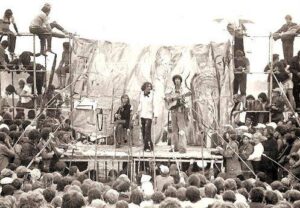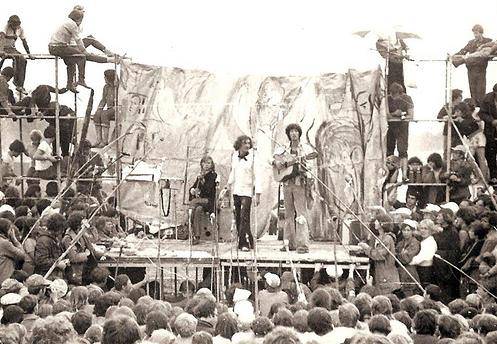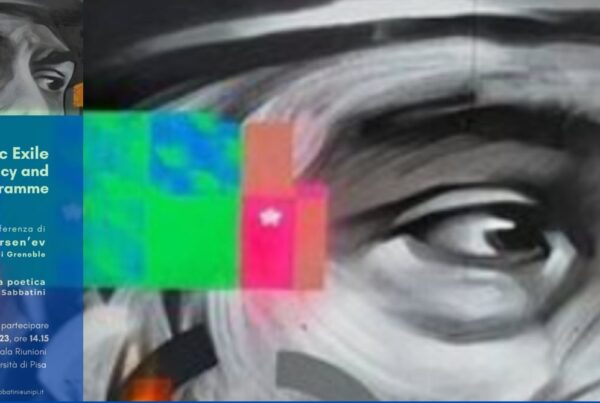Dates: 1950s–1990s

Ensemble ‘Poslednii shans’ at the XXV meeting of the KSP, 16 May 1981. Source: Sound Archives V. S. Buriak.
Places: Moscow, Leningrad, Odessa
Description:
The phenomenon denoted by the term magnitizdat is complex, and it is difficult to offer a clear and exhaustive taxonomy. Therefore, this text refers to a precise type of audio recording related to the genre of songwriting (avtorskaia pesnia), with particular regard to songs emanating from the Clubs of Independent Song (Klub samodeiatel’noi pesni, KSP), which did not pass through official channels and could only be performed under precise, often semi-official, conditions (cf. Karimov 2004). Other genres of sound recordings, including interviews, poetry readings and political speeches, along with sketches by comedians and parodists who travelled extensively via clandestine circuits, fall outside the scope of this investigation.The first studio to clandestinely record audio material, the Zvukozapis’ (literally “audio recording”) studio, was founded in 1946 in Leningrad; its founder, Stanislav Filonov, a radio engineer and sound technician, owned a German Telefunken recorder with which recordings could be copied or live music recorded directly using a microphone (cf. Belyi 2009). Throughout the 1950s, however, such initiatives remained a niche and were closely watched by the police. In the 1960s tape recorders, until then largely unavailable, started to enter many homes (cf. Sosin 1975: 277), with a real boom taking place in the 1970s, coinciding with more restrictive censorship than in under Khrushchev. The activities of the tamizdat and the samizdat grew and were quickly followed by the magnitizdat. Hundreds of songs by the most famous authors – Okudzhava, Galich, Vysotskii – were joined by the work of new “bards” (cf. Smith 1984: 95).
There were several reasons for this, first and foremost the pressure of censorship and the limitations imposed on most repertoires circulating in the KSPs. As in the previous decade, many songs could only be heard in out-of-town gatherings, at home concerts, around a fire or on improvised stages far from the watchful eye of the authorities. Moreover, it was impossible to legally buy any song of this type, except for some rare vinyl editions.
At the same time, and partly as a result of this state of affairs, the number of members of the KSP movement (fans and songwriters or performers) increased dramatically in towns and villages throughout the Soviet Union and by the mid-Seventies the first cassettes were starting to appear. The contribution from radio stations was also fundamental, in particular Radio Liberty, which by 1974 had an estimated 36 million private shortwave listeners in the Soviet Union (cf. Kabachkin 1972).
In the 1980s there was an initial surge in the clandestine circulation of records and cassettes, due to the closure of many KSPs all over the country, a process that slowed down in the second half of the decade thanks to changes brought about by Perestroika. In the 1990s, there was a decline in the unofficial distribution of sound recordings as legal recordings began to flood the music market of the now former Soviet Union. By the 2000s, the magnitizdat came to an end as citizens of the former Soviet Republics had almost unrestricted access to audio recordings online.
It is difficult to draw up a geographical map of magnitizdat activity. Magnitizdat hotspots tended to be areas with a local KSP or active KSP members making geographical location as a factor largely irrelevant. In Moscow and Leningrad, the high concentration of KSPs led to a wide distribution of magnitizdat material. In Odessa, from the mid-Sixties, a system for broadcasting recordings operated thanks to groups of sound engineers and technicians, who were often also music collectors.
The authorities countered by restricting the activity of the KSPs or even ordering their closure. In the two “capitals”, the struggle was intense as the KSPs were less easy to control; in the suburbs the actions of the authorities were more effective due to the small size of the “counterculture” centres. However, individuals and groups willing to copy and disseminate documents and audio material collected during trips, expeditions and random or organized meetings were present throughout the country, making magnitizdat a widespread practice that proved difficult to restrict or control.
Giulia De Florio
[30th June 2021]
Bibliography
- Amal’rik A., Prosushestvuet li Sovetskii Soiuz do 1984 goda?, Amsterdam, Fond imeni Gertsena, 1970 (2 ed.).
- Belyi I., Buihm III, Memories, Moskva 2009.
- Daughtry J. Martin, “Sonic Samizdat”: Situating Unofficial Recording in the Post-Stalinist Soviet Union, Poetics Today, 30.1 (2009): 27-65.
- Kabachkin V., Magnitizdat, series of Radio Liberty Russian broadcasts, 13, 5 October 1972.
- Karimov I., Istoriia moskovskogo KSP, Ianus-K, Moskva 2004.
- Smith G., Songs to Seven Strings: Russian Guitar Poetry and Soviet “Mass Song”, Indiana University Press, Bloomington 1984.
- Sosin G., ‘Magnitizdat’: Uncensored Songs of Dissent, in R. L. Tokes, (ed.), Dissent in the USSR: Politics, Ideology and People, The John Hopkins University Press, Baltimore-London 1975: 276-309.
To cite this article:
Giulia De Florio, Soviet Songwriting: Periods and Places, in Voci libere in URSS. Letteratura, pensiero, arti indipendenti in Unione Sovietica e gli echi in Occidente (1953-1991), a cura di C. Pieralli, M. Sabbatini, Firenze University Press, Firenze 2021-, <vocilibereurss.fupress.net>.
eISBN 978-88-5518-463-2
© 2021 Author(s)
Content license: CC BY 4.0





